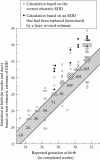Gestational assessment assessed
- PMID: 9462193
- PMCID: PMC1720713
- DOI: 10.1136/fn.77.3.f216
Gestational assessment assessed
Abstract
Aims: To review the accuracy with which obstetric information on gestation is recorded in the neonatal records; and the reliability of the methods used for assessing gestational age after birth.
Methods: Service information on all babies born in 1989, and research information on all babies of < 32 weeks gestation born in the Northern Region in 1990-91, were reviewed to determine the accuracy with which antenatally collected information had been recorded in the neonatal records after birth. A prospective study was also mounted to assess how reliably paediatric staff could assess the gestational age of babies born to mothers with certain obstetric dates under service conditions. Paediatric residents looked at 347 babies of > 32 weeks gestation, and senior staff looked at 105 babies of < 30 weeks gestation.
Results: The best techniques for estimating gestation immediately after birth were only half as accurate (95% CI +/- 17 days) as estimates based on antenatal ultrasound at 15-19 weeks gestation. Assessments that relied on the tone, posture, and appearance of the baby at birth in those of < 32 weeks gestation were less reliable than assessments based on a retrospective review of when various reflex responses first appeared. They also tended to overestimate true gestation. Antenatal information of high quality was ignored, and arithmetic and transcription errors were introduced during the transfer of antenatal information into over 10% of postnatal records.
Conclusions: Current ultrasound techniques for "dating" pregnancy antenatally are better than any of the methods of postnatal assessment. Given the reliability of the antenatal information now available, it is regrettable that so many inaccuracies have been allowed to creep into the routine computation and recording of gestation at birth.
Figures



References
MeSH terms
LinkOut - more resources
Full Text Sources
Medical
